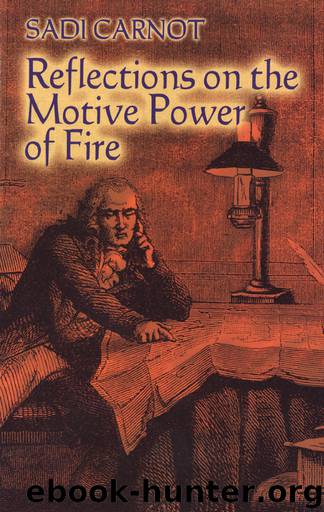Reflections on the Motive Power of Fire by Sadi Carnot

Author:Sadi Carnot
Language: eng
Format: epub
Publisher: Dover Publications
On which he remarked, that the mean pressure is more than half the original pressure; also that in employing a quantity of steam equal to a quarter, it would produce an effect more than half.
Watt here supposed that steam follows in its expansion the law of Mariotte, which should not be considered exact, because, in the first place, the elastic fluid in dilating falls in temperature, and in the second place there is nothing to prove that a part of this fluid is not condensed by its expansion. Watt should also have taken into consideration the force necessary to expel the steam which remains after condensation, and which is found in quantity as much greater as the expansion of the volume has been carried further. Dr. Robison has supplemented the work of Watt by a simple formula to calculate the effect of the expansion of steam, but this formula is found to have the same faults that we have just noticed. It has nevertheless been useful to constructors by furnishing them approximate data practically quite satisfactory. We have considered it useful to recall these facts because they are little known, especially in France. These engines have been built after the models of the inventors, but the ideas by which the inventors were originally influenced have been but little understood. Ignorance of these ideas has often led to grave errors. Engines originally well conceived have deteriorated in the hands of unskillful builders, who, wishing to introduce in them improvements of little value, have neglected the capital considerations which they did not know enough to appreciate.
* The advantage in substituting two cylinders for one is evident. In a single cylinder the impulsion of the piston would be extremely variable from the beginning to the end of the stroke. It would be necessary for all the parts by which the motion is transmitted to be of sufficient strength to resist the first impulsion, and perfectly fitted to avoid the abrupt movements which would greatly injure and soon destroy them. It would be especially on the working beam, on the supports, on the crank, on the connecting rod, and on the first gear wheels that the unequal effort would be felt, and would produce the most injurious effects. It would be necessary that the steam cylinder should be both sufficiently strong to sustain the highest pressure, and with a large enough capacity to contain the steam after its expansion of volume, while in using two successive cylinders it is only necessary to have the first sufficiently strong and of medium capacity—which is not at all difficult—and to have the second of ample dimensions, with moderate strength.
Double-cylinder engines, although founded on correct principles, often fail to secure the advantages expected from them. This is due principally to the fact that the dimensions of the different parts of these engines are difficult to adjust, and that they are rarely found to be in correct proportion. Good models for the construction of double-cylinder engines are wanting, while excellent designs exist for the construction of engines on the plan of Watt.
Download
This site does not store any files on its server. We only index and link to content provided by other sites. Please contact the content providers to delete copyright contents if any and email us, we'll remove relevant links or contents immediately.
The Complete Stick Figure Physics Tutorials by Allen Sarah(7336)
Secrets of Antigravity Propulsion: Tesla, UFOs, and Classified Aerospace Technology by Ph.D. Paul A. Laviolette(5332)
Thing Explainer by Randall Munroe(3909)
The River of Consciousness by Oliver Sacks(3572)
The Order of Time by Carlo Rovelli(3162)
How To by Randall Munroe(3074)
A Brief History of Time by Stephen Hawking(2991)
I Live in the Future & Here's How It Works by Nick Bilton(2958)
What If?: Serious Scientific Answers to Absurd Hypothetical Questions by Randall Munroe(2667)
The Great Unknown by Marcus du Sautoy(2661)
Midnight in Chernobyl by Adam Higginbotham(2515)
Blockchain: Ultimate Step By Step Guide To Understanding Blockchain Technology, Bitcoin Creation, and the future of Money (Novice to Expert) by Keizer Söze(2467)
Networks: An Introduction by Newman Mark(2382)
The Meaning of it All by Richard Feynman(2318)
Easy Electronics by Charles Platt(2308)
The Tao of Physics by Fritjof Capra(2247)
Midnight in Chernobyl: The Untold Story of the World's Greatest Nuclear Disaster by Adam Higginbotham(2195)
When by Daniel H Pink(2098)
Introducing Relativity by Bruce Bassett(2097)
